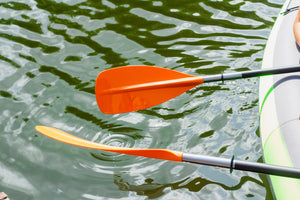How to choose kayak paddle
May 08, 2021
Choosing from the variety of kayak paddles on the market is no small feat. Kayak paddles come in a variety of materials, lengths, and blade shapes.
Let us take you through some of the important things to consider when choosing the right kayak paddle for you, from the size kayak paddle you need, to blade shapes and materials.
Choosing the paddle blade shape
The shape of the paddle blades determines how it interacts with the water. So, the key determining factor for paddle blade shape will be the type of kayaking you're doing.
High Angle Paddle
Paddle blades referred to as high angle are designed to be held more vertically during a forward stroke. High angle paddles are shorter and broader.
For paddlers who are racing or paddling on rough or whitewater, these paddles are a good choice. They give you a more powerful stroke to move faster through the water and lots of control in difficult conditions.

High angle paddles are a good choice for those paddling in rough waters
Low Angle Paddle
While high angle paddles are designed to be held more vertically, low angle paddles are designed to be held more horizontally.
Your hands will be closer together in height through your stroke. This technique is less tiring and therefore good for kayak touring or multi-day trips.
Low angle paddles have a longer and skinnier blade than the high angle alternatives.
The shape of the paddle blades determines how it interacts with the water.
Wing-Shaped Blade
The wing blade is designed for an even more vertical paddle than the high angle blade. This makes it a good choice for racers, but may prove uncomfortable for recreational paddlers.
These blades have one face with a shallow scoped shape which helps to increase the efficiency and power of your forward stroke.
Dihedral Blades
Dihedral blades have two power faces. They intend to minimise vibration during the stroke, allowing your blade to better catch the water.
You can tell a blade is dihedral because it will have two faces sloping slightly down from the middle of the blade.
Picking your kayak paddle size
There are a few points that will determine what kayak paddle length you need.
Body stature
You may think your height will be the main deciding factor in your kayak paddle sizing. But actually your torso length is more important to choose a paddle.
The easiest way to measure your torso is to sit down in a straight-backed chair and measure the distance from the seat to your nose. This is your torso length.
The other option is if you're already on the water with a paddle. Try holding your paddle out in front of you - make sure your arms are bent at 90-degree angles. If your hands fall around two-thirds from the middle of the paddle to where the shaft and blade meet, the paddle is a good fit for you.
Kayak activity
The type of kayaking activity you'll be doing will also determine your kayak paddle sizing.
Racers or those tackling whitewater will find that a shorter paddle allows you to take shorter and faster strokes.
Kayak design
As a simple rule of thumb, the wider the kayak you're paddling, the longer the kayak paddle length you'll need. This enables you to maintain proper paddling form when reaching beyond the edges of your kayak. Otherwise, you could lose some all important power from the paddle in the water.

As a simple rule of thumb, the wider the kayak you're paddling, the longer the kayak paddle length you'll need
As an example, tandem kayak paddles are generally longer than those used in a solo recreational kayak due to their width.
However, your stature will still come into play, so you need to balance these elements.
Stroke angle
Finally, consider your preferred stroke angle.
If you prefer a high stroke, then a shorter paddle would be better.
For a lower stroke angle - often used in casual touring - a slightly longer paddle would be best.
Adjustable
If you need a little more flexibility in your paddle length, then why not opt for an adjustable paddle? Generally, they can extend up to 10cm, for example from 230 cm to 240 cm, and can provide you with more options.

This includes using them on a boat with a different width, or sharing in the family.
Paddle materials
Paddles come in a wide variety of materials. The material you choose will come down to elements such as price and durability. Here we take you through some of the main paddle materials you'll see in the market.
Plastic
Plastic paddles are common due to their price and durability. The maintenance is low, but you will find that they're heavier than fiberglass and carbon fiber alternatives.
They have thicker edges and more flex than the alternatives, which can lead to a less efficient stroke. Plastic is a good solution for recreational paddling, or as a spare.
Aluminium
Aluminium paddles are also at the cheaper end of the price scale, but are still heavy like their plastic counterparts.
Due to their price point, many people start with an aluminum paddle before upgrading to a lighter material if they become a more serious kayaker.
Heavier paddles are more tiring and the shaft can be cold to the touch in cooler weather, but they are a good beginner paddle or a spare. In this way, they are not dissimilar to plastic paddles.
Fiberglass
Fiberglass is a very popular paddle material because its inexpensive, but unlike plastic and aluminum, it's also lightweight.
Fiberglass paddle shafts tend to be strong and can withstand a fair amount of abuse.
A common choice for touring and recreation, the mid-range paddles will often have fiberglass blades and carbon shafts. This makes for a compromise between weight, price and durability.

Fiberglass blades and carbon fiber shafts can be a good compromise in terms of cost and performance
Wood
Similar to fiberglass paddles, a wooden paddle is lightweight as well as inexpensive.
Some people prefer how wood paddles look, though you won't see them very often. Wooden paddles are rigid and tough, and can last a long time.
Unlike aluminium paddles, the shaft will be warm to the touch and mid-range in terms of weight.
However, be aware that they do need upkeep, including sanding and varnishing.
Carbon fiber
A carbon fiber kayak paddle is top of the range. It is the most expensive and highest quality material for your paddle.
Its benefits are that carbon fiber is extremely light while also being very strong and stiff. It's the best paddle for a long kayak touring trip, or sea kayaking, and the shaft feels warmer on your hands than aluminum.
However, their price points mean that they are only for the most serious paddler who needs top-end performance.
If it's possible, take a potential paddle for a test drive on the water. The most important thing in a paddle is how it feels.
What is feathering?
When shopping for a kayak paddle, you may come across the term "feathering". This isn't for the birdlife, but rather refers to the angle of the two blades.
A simple way to understand if a paddle is feathered is by laying it on the ground - if both blades are at an equal angle, then the paddle is "unfeathered". If they are at different angles, then the paddle is feathered.
To feather or not to feather?
The purpose of feathered paddles is to decrease resistance from headwinds or tailwinds - one blade is positioned to cut through the air while the other pushes water.
Beginner kayakers may find basic skills like bracing and rolling more challenging with a feathered blade.
For paddlers doing a lot of kayak touring in open water, feathered kayak paddles can be a great choice for easing the challenge in those conditions. However, recreational paddlers may not require feathering.
If you can't decide, some two-piece paddles allow you to adjust your kayak paddle between feathered and unfeathered.

Some two-piece paddles allow you to switch between feathered and unfeathered
One or two piece paddle?
You will also see one piece and two (or multiple) piece kayak paddles on the market.
A multi-piece paddle is a good choice for storage - you can break it down and store it in your kayak, or bring it as a spare for travelling.
However, day-to-day many paddlers prefer one-piece options as they are lighter and more efficient. Multi-piece options can also become worn down at the joints, or "ferrules", from the salty air and water.
Bent or straight shaft kayak paddle?
Most kayak paddles have straight shafts, but you may also see some shafts with slightly bent sections. These bent sections are good for kayakers requiring a more neutral wrist position.
They are normally pricier, but those travelling long distances or who are prone to wrist pain, may find a bent kayak paddle shaft a good investment. However, others may find that the bent shafts feel less natural when paddling.
It will come down to personal preference so, if you can, get out on the water and give both designs a go.
Ready to hit the water? Check out these related articles
Now you know how to pick the kayak paddle for you, why not read these related articles?
- Safety first: read our beginner's guide to kayak safety
- Discover our guide to finding the right size kayak for you
- Explore our guide to finding the best kayak for you

